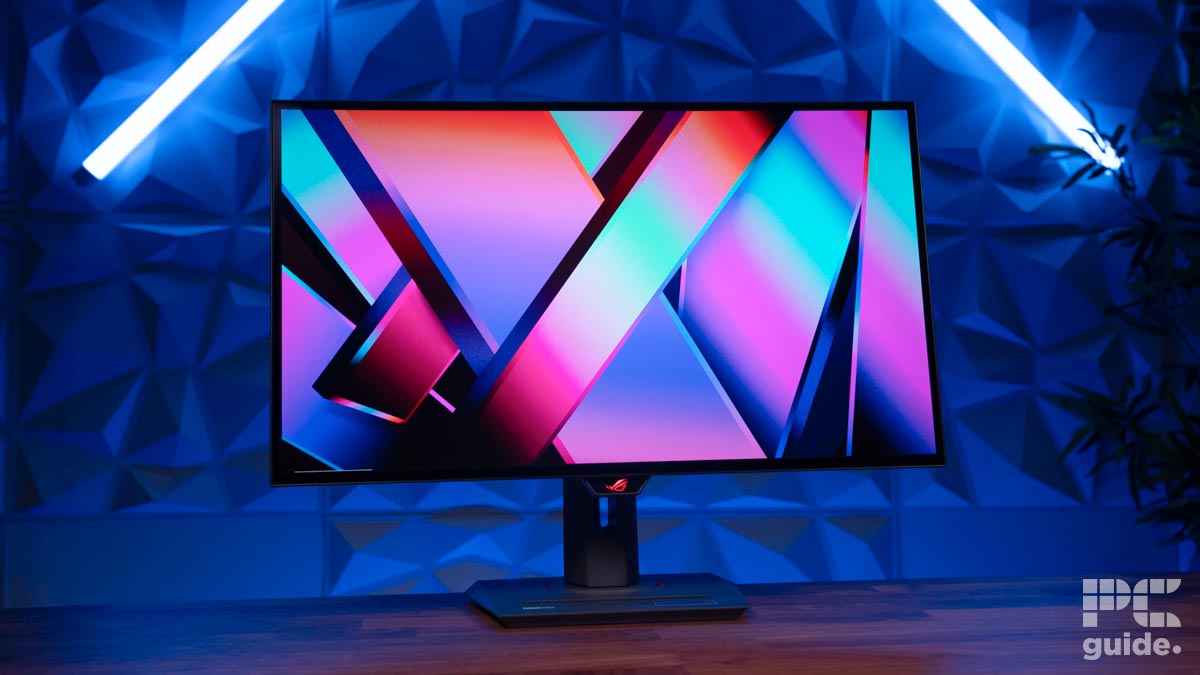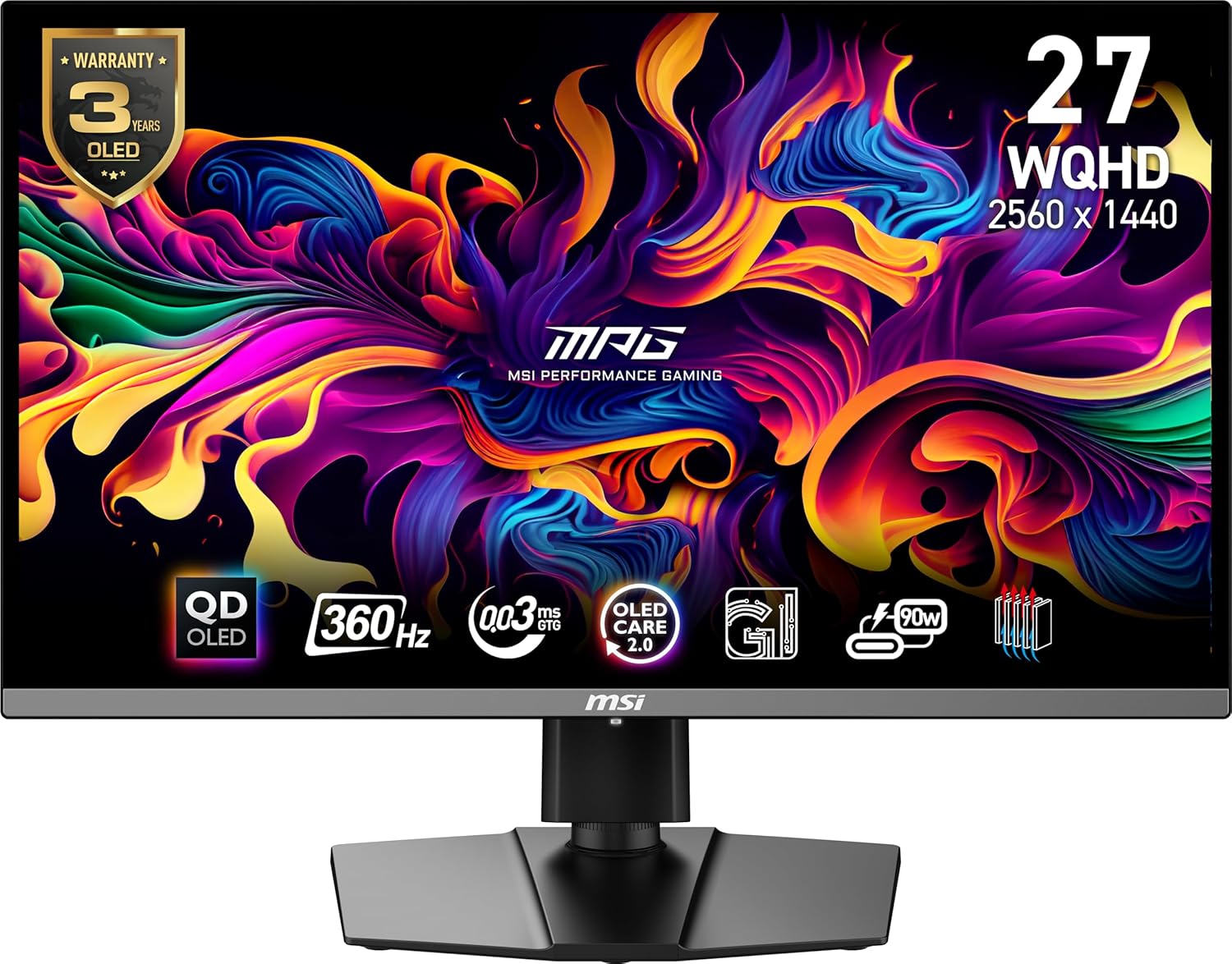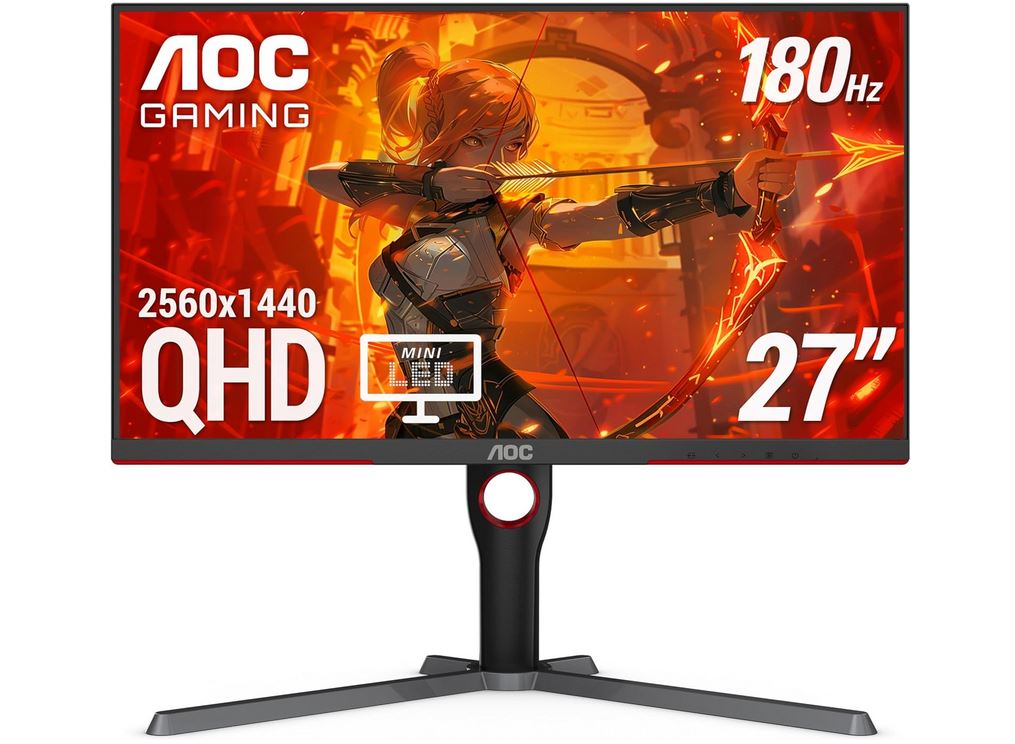Best 27 inch monitor 2025: covering gaming, productivity & creator displays

Table of Contents
27 inch monitors remain the most common size screens, for both gaming monitors, for video editing monitors or other creative uses, or general productivity displays. They offer the perfect middle ground between screen real estate when working or for providing sufficient immersion when viewing media or gaming, and not taking up too much space on your desk or costing an arm and a leg to buy. 27-inches is also pretty much the maximum screen size that most people can comfortably fit on their desks in a dual-monitor setup.
This guide will look at the best 27 inch monitors currently available to buy as of 2025, and will cover a variety of use-cases and budgets, so you're bound to find one that will suit your needs. At this size of screen, the majority of these displays will be 1440p monitors, though we will be adding higher resolution and lower resolution picks to this guide where applicable.
-
MSI MPG QD-OLED 27″ Gaming Monitor (271QRX)
- Panel type: QD-OLED panel
- Resolution: 2560 x 1440
- Refresh rate: 360Hz
- Response time: 0.03ms
- Panel size: 27″
-
Sony INZONE M10S (27″, OLED)
- Panel type: WOLED
- Resolution: 2560 x 1440
- Refresh rate: 480Hz
- Response time: 0.03ms
- Panel size: 27″
- I/O ports: 1x DisplayPort 2.1, 2x HDMI 2.1, 2x USB-A, 1x USB-B, 1x 3.5mm audio jack
-
AOC Q27G3XMN 27″ Gaming Monitor
- Panel type: VA (with Mini-LED backlighting)
- Resolution: 2560 x 1440
- Refresh rate: 180Hz
- Response time: 1ms
- Panel size: 27″
-
Xiaomi G Pro 27i Gaming Monitor (QHD)
- Panel type: IPS (with Mini-LED backlighting)
- Resolution: 2560 x 1440
- Refresh rate: 180Hz
- Response time: 1ms
- Panel size: 27″
-
ASUS ProArt PA27JCV Monitor
- Panel type: IPS
- Resolution: 5K (5120 x 2880
- Refresh rate: 60Hz
- Panel size: 27″
24 inch vs 27 inch vs 32 inch monitor size comparison
Assuming we are limiting ourselves to 16:9 aspect ratio displays, a 27 inch monitor has a diagonal measurement that is 12% larger (the additional 3 inches) which translates to an increase in screen area of 27%.
Compared to a 32-inch monitor, a 27-inch display is 16% smaller diagonally and 29% smaller in terms of total area.

- Panel type: QD-OLED panel
- Resolution: 2560 x 1440
- Refresh rate: 360Hz
- Response time: 0.03ms
- Panel size: 27″
- 360Hz with excellent response time
- OLED panel has fantastic contrast ratio
- 99% DCI-P3 coverage & high color accuracy
- Great HDR performance
- KVM switch, USB hub & 90W USB-C power delivery
- Text legibility could be better
- Not very bright in SDR mode
- Not the cheapest
If your wallet can stretch to it, the MSI MPG 271QRX stands out as the top 27-inch gaming monitor in our book, that's also great for many creative tasks. Built with competitive gamers in mind, this 1440p resolution, QD-OLED display emphasizes speed and accuracy, boasting a lightning-fast 360Hz refresh rate and an ultra-low 0.03ms g2g response time. The result is silky-smooth, ultra-responsive gameplay that even outperforms many other OLED models known for their quick reactions. It's also HDMI 2.1-ready, meaning it pairs nicely with next-gen consoles.
Color reproduction is another strong suit, with 99% DCI-P3 and 100% sRGB coverage, along with impressive color accuracy, making it suitable not just for gaming but also for creative work. Thanks to OLED tech, you also get perfect blacks and exceptional contrast, ideal for HDR content. The glossy panel helps colors and highlights pop, whether you’re playing a game or watching a movie.
That said, like many OLED displays, it isn't the best for general office use due to limitations on text sharpness (with color fringing affecting clarity) and peak brightness. The 254-nit peak brightness in SDR full-screen mode may not be ideal for brightly lit rooms and the glossy finish works against it here: adding glare. On the flip side, the monitor offers several features that are a boon to productivity users: a built-in USB hub, 90W USB-C power delivery, and an integrated KVM switch, which make it a highly versatile choice beyond just gaming.

- Panel type: WOLED
- Resolution: 2560 x 1440
- Refresh rate: 480Hz
- Response time: 0.03ms
- Panel size: 27″
- I/O ports: 1x DisplayPort 2.1, 2x HDMI 2.1, 2x USB-A, 1x USB-B, 1x 3.5mm audio jack
- The fastest refresh rate in the game & excellent response time
- OLED panel has fantastic contrast ratio
- 100% sRGB coverage & high color accuracy
- Expensive
- Not the brightest
- 480Hz refresh rate is unnecessary for most consumers
Sony's INZONE M10S is another premium 27-inch, 1440p, OLED gaming monitor, which stands out from the crowd thanks to its jaw-dropping 480Hz refresh rate – the highest currently available on the market for this resolution of screen. While such a speed only really matters if your system can push equally high frame rates, it gives a very nice advantage for competitive players running lightweight titles like CS2 or Call of Duty on high-end rigs.
This monitor is tailored for esports from top to bottom, including unique features like FPS Pro+ mode (developed with the Fnatic team) that enhances target visibility, and a 24.5-inch screen mode, mirroring the setup used by pro players. You also get near-instant response times expected from OLED, support for both G-Sync and FreeSync, and impressively low input lag (with a slight bump at 60Hz). Burn-in prevention is handled through robust software tools and a dedicated heatsink for heat control.
As with most OLED panels, image quality is stellar. You'll get rich contrast, perfect blacks, and full sRGB coverage with solid color accuracy, making it suitable for occasional creative or color-critical work as well.
However, brightness is a weak point. Despite the inclusion of Micro Lens Array+ (MLA+) technology, the screen peaks at around 245 nits in full-screen SDR – fairly standard for OLEDs and less than ideal in brightly lit environments. That, alongside its steep price tag, are the only real drawbacks to what is otherwise a cutting-edge display built for serious competitors.

- Panel type: VA (with Mini-LED backlighting)
- Resolution: 2560 x 1440
- Refresh rate: 180Hz
- Response time: 1ms
- Panel size: 27″
- Great contrast thanks to 336 dimming zones
- Great value for money
- Good brightness thanks to Mini-LED backlighting
- 99% sRGB coverage & high color accuracy
- Some black smearing in fast-moving scenes
- Suffers from a slight red tint on some presets
- No HDMI 2.1 support
Named our 2024 Gaming Monitor of the Year, the AOC Q27G3XMN offers standout performance at a wallet-friendly price. The display strikes an ideal balance for everyday gamers: combining sharp visuals, solid brightness, and a decent refresh rate, specifically, you get 2560×1440 across the 27” panel, a very impressive 630 nits of brightness (around 410 nits with dimming), and a 180Hz refresh rate.
Such a high brightness is possible thanks to the enhanced Mini-LED backlighting behind the VA panel, which features 336 local dimming zones, and makes it as suitable for well-lit spaces as it is for darker ones with its deep blacks and strong contrast. So good is the contrast that it comes with a VESA DisplayHDR 1000 certification, signifying its proficiency with handling HDR content
Response times aren't as good as you'd find on an OLED panel, but they're still reasonable, although one downside you may experience is black smearing during fast-paced scenes – a typical VA panel drawback. Many of the presets within the monitor also skew overly red, though a bit of manual calibration can correct this easily. With 99% sRGB coverage and decent color accuracy, the screen is still a capable option for casual content creation.
Other minor cons include narrow viewing angles, a lack of HDMI 2.1, and a fairly basic design. Still, considering the price, these compromises are more than reasonable for what the Q27G3XMN delivers.

- Panel type: IPS (with Mini-LED backlighting)
- Resolution: 2560 x 1440
- Refresh rate: 180Hz
- Response time: 1ms
- Panel size: 27″
- Great value for money
- Fantastically high peak SDR brightness
- 99% sRGB/ 99% DCI-P3 coverage & high color accuracy
- Weak contrast unless local dimming is enabled
- No HDMI 2.1 support
- No USB-C ports
Similar to the AOC Q27G3XMN above, the Xiaomi G Pro 27i is another good value 180Hz, 1440p gaming monitor that comes with Mini-LED backlighting, but this time paired with an IPS panel. Once again this allows it to achieve outstanding full-screen SDR brightness levels. In fact, its peak brightness hits around 890 nits, the highest of any monitor mentioned here, making it especially suitable for use in bright or sunlit environments where other screens may struggle.
In terms of color performance, the G Pro 27i delivers excellent results. It offers impressive accuracy and coverage across both the sRGB and DCI-P3 gamuts, making it a viable option for color-sensitive work such as photo editing, video grading, or graphic design. However, one area where this monitor underwhelms is its contrast ratio. Like many IPS-based displays, blacks can appear more washed out, especially in darker settings. Fortunately, enabling its local dimming feature can somewhat improve perceived contrast, helping deepen blacks and enhance the overall visual experience.
When it comes to gaming, the 180Hz refresh rate is more than adequate for most players and ensures a smooth experience in fast-paced titles. Response times are decent as well, though they don't quite reach the near-instantaneous levels seen in OLED models. Still, for the price, performance remains strong.
That said, there are a few compromises to consider. Unlike some higher-end alternatives, the G Pro 27i lacks HDMI 2.1 ports, meaning it’s not the best choice for current-gen console players seeking higher refresh rates. It also omits USB-C connectivity, which may be a drawback for users wanting a cleaner, more modern setup with fewer cables. Overall, while not without its flaws, the Xiaomi G Pro 27i offers great performance for the asking price.

- Panel type: IPS
- Resolution: 5K (5120 x 2880
- Refresh rate: 60Hz
- Panel size: 27″
- 5K resolution
- Great contrast for a non-OLED
- 100% sRGB / 99% DCI-P3 coverage & high color accuracy
- More affordable than the Apple alternative
- Lots of connectivity options including 96W USB-C
- Adobe RGB coverage limited to 88%
- Max refresh rate of 60Hz & low response time
- Medicore build quality
The ASUS ProArt PA27JCV is a very high-res monitor tailored for creative professionals seeking exceptional color accuracy and high pixel density. This 5K (5120×2880) beast has a pixel density of 218 PPI, offering sharp visuals ideal for detailed photo and video editing. It's basically a cheaper (relatively speaking) version of the Apple Studio Display, though it doesn't quite have the same aesthetic flair or premium build quality, being a bit on the plasticky side.
Equipped with an IPS panel and edge-lit W-LED backlight, the PA27JCV supports 10-bit color depth (8-bit + FRC), high color accuracy out of the box, and covers 100% sRGB, 99% DCI-P3, and approximately 88% Adobe RGB color spaces – this means you can comfortably work in the first two space, but sadly not in Adobe. Full screen SDR brightness is around the 380 nits mark, which is reasonable and better than what you'll find in an OLED display. The monitor also supports HDR10 with a peak brightness of 500 nits, though the absence of local dimming limits its HDR performance compared to displays with full-array local dimming. Contrast is great, even if it's not up there with what you'd get with an OLED.
Connectivity options include HDMI 2.1, DisplayPort 1.4, and USB-C with 96W power delivery, facilitating seamless integration with various devices and reducing cable clutter. The built-in KVM switch allows users to control multiple systems using a single keyboard and mouse setup. Additionally, the monitor incorporates ASUS LightSync technology, which uses ambient light sensors to adjust brightness and color temperature dynamically, ensuring consistent visual performance in varying lighting conditions.
The 60Hz refresh rate and 5ms response time make it less suitable for high-motion content or gaming, but then again that's not really what you're buying a monitor like this for.
How we pick the best 27-inch monitors
We take a detailed and research-driven approach when choosing the top gaming monitors. Whenever possible, we conduct hands-on testing of each model, evaluating factors like color accuracy, gamut coverage, brightness levels, contrast ratio, white and black points, gamma performance, and panel consistency. To carry out these assessments, we rely on DisplayCAL software paired with the X-rite i1Display Pro calibration tool. Beyond raw performance, we also assess each monitor's specifications, construction quality, ergonomic design, and suitability for different gaming scenarios – always weighing up their overall value in relation to their price tag.
27 inch monitor FAQ
For more info on 27 inch monitors, have a read of the below Frequently Asked Questions.
Is 1440p good on 27-inch monitor?
1440p resolution does indeed look good on a 27-inch monitor. On a 24-inch screen or lower 1080p resolution will be just fine to achieve a nice sharp image, and you can still get away with it at 27-inches, though this is the size where we'd recommend upgrading to 1440p/QHD for most people to achieve that nice high PPI.
Of course, if your focus is on gaming then you'll need to make sure your PC is sufficiently powerful to play games at 1440p resolution first, as this will lower your FPS compared to 1080p considerably.
What is PPI?
PPI stands for Pixels Per (Square) Inch, and it helps us give a better indication of how these monitors will actually compare to one another in terms of fidelity.
The bigger the number, the denser the pixels. The denser the pixels, the harder it is to individually see them, which is pretty important for monitors since you are usually sitting close to them.
When viewed at an average desktop viewing distance, you typically want your desktop display to have at least 90 PPI. This lines up with a 24-inch 1080p monitor, and it means you shouldn't notice any blurring or pixelation unless you intentionally lean in and squint for it.
Below, we've listed the PPI for common resolutions at 27 inches:
- 720p (HD): ~54 PPI.
- 1080p (Full HD): ~81 PPI.
- 1200p (Full HD): ~78 PPI.
- 1440p (QHD): ~109 PPI.
- 1600p (QHD+): ~108.79 PPI.
- 2160p (4K): ~163 PPI
